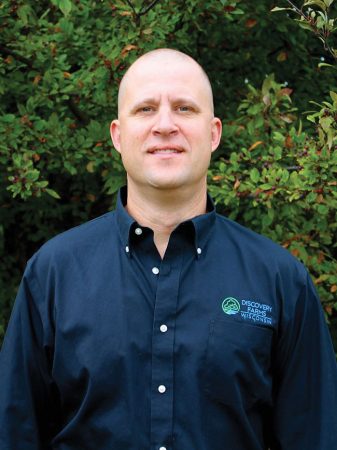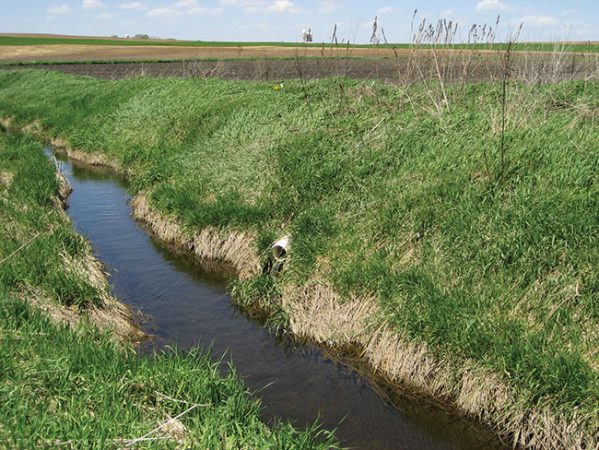
Features
Contractor at Work
Tile drainage in Wisconsin
A glance into drainage activity in the Badger State.
November 25, 2019 By Madeleine Baerg
 Due to the variability of Wisconsin’s landscape and soil, drainage tile patterns across the state are often mixed.
Due to the variability of Wisconsin’s landscape and soil, drainage tile patterns across the state are often mixed. Wisconsin may lag behind other Midwest states in total running feet of installed tile drainage, but it is a leader in helping farmers make good drainage decisions.
“Wisconsin is a very progressive state,” says Eric Cooley, co-director of the University of Wisconsin’s (UW) Discovery Farms. “We’re also one of most regulated states from an agricultural standpoint. The rules that dictate agricultural production here are some of most stringent in the country. And, the fact is that we’re a heavy dairy state, so a lot of land receives manure application, which means we really have to be careful about drainage.”
Together, he says, those factors mean Wisconsin is making important steps forward in installing tile drainage right.
Farmer-led UW Discovery Farms is one of multiple water-quality focused initiatives in the state, complimenting the work of locally run conservation projects. The program, which offers a variety of resources, events and extension initiatives, unites researchers and farmers in the common goal of optimizing agriculture while minimizing nutrient run-off, conserving soil and supporting healthy waterways.
“Farmers are the ones who are out there; they know the intricacies of their land. They want to do the right things. We’re just giving them the tools to be able to,” Cooley says.
According to Cooley, it’s surprisingly hard to estimate how much of Wisconsin’s farmland is tile drained today. That’s because there is no central record of drainage installation. Instead, most calculations depend on farmer’s estimates, which can be problematic.
Multiple studies have tried to estimate drainage infrastructure across the Midwest using different data collection methods, however results from various studies have returned very different. What is certain is that, compared to other states, Wisconsin has a relatively low percentage of tile-drained agricultural land. Whereas farmers reported in the 2012 Census of Agriculture that approximately eight percent of total agricultural land in Wisconsin was tile drained, their counterparts across most of the rest of the Midwest reported four and five times as much drainage: Illinois, Minnesota and Michigan all reported over 30 percent and Ohio, Indiana and Iowa reported over 40 percent.

Eric Cooley is the co-director of the University of Wisconsin’s Discovery Farms. Farmer-led UW Discovery Farms is one of multiple water-quality focused initiatives in the state, complimenting the work of locally run conservation projects.
Most of Wisconsin’s tile drainage is installed along the state’s eastern and southern edges that drain into the Lake Michigan Basin. The land in that area is characterized by huge variability. Different regions – often even different parts of individual farms – feature highly variable topography, challenging sub-surface drainage issues like potholes and restrictive layers, and soil types varying from shallow to deep and from sandy to heavy clay.
“There’s a real mix of reasons we tile here,” Cooley says. “Mostly, it comes down to the fact that eastern Wisconsin, which is where most of the tile drained land is, was a glaciated area. A glacier came and scraped everything off and then dumped it back. We have all these diverse features to our landscape, there’s nothing consistent. We have hills and valleys, potholes without outlets, and very variable soils. That’s why having someone experienced and trained to help design and install your drainage is such a priority.”
Given that variability of Wisconsin’s landscape and soil, it’s not surprising that drainage tile patterns are mixed across the state and often even on individual farms. On flat and consistent land, farmers tend towards pattern (gridiron) tiling. In potholed and sloped areas, they often use a natural pattern: a main trunk with branches that drain isolated depressions. In hilly areas, the most effective option is a herringbone pattern to drain valleys and narrow depressions. That said, herringbone is seldom used because it is more expensive and challenging to install.
“Tile is a good thing. It’s a wonderful thing. It reduces surface soil loss and nutrient run-off, but you need to do it right. If it’s not put in correctly, it can give a black eye to tile drainage on the environmental side by causing very problematic downstream effects. There are a lot of challenges to installing drainage in Wisconsin that even experienced tilers can struggle with,” Cooley says.
“There are a lot of challenges to installing drainage in Wisconsin that even experienced tilers can struggle with.”

Most of Wisconsin’s drainage tile is installed along the state’s eastern and southern edges that drain into the Lake Michigan Basin.
Much of the tile work currently underway in the state is to fix and replace clay and concrete systems installed in the 1960s.
“The systems that were installed 60 or more years ago are hitting the end of their life expectancies. As they start to degrade and deteriorate, what we’re starting to see is a lot more tile blow-outs,” Cooley explains. “Farmers are fixing and fixing until that just doesn’t make sense, and then they have to break up the old and replace it.”
According to Cooley, today’s tough economic times mean fewer farmers are investing in tile drainage.
“A lot of contractors say they’ve had a tough time keeping up with demand in recent years, but we’re going through a bit of a dip recently,” he adds. “When you have extra money to make improvements, then you are more likely to spend it. Right now, a lot of people are just trying to stay afloat.”
Expect that to change looking forward. As farm land values increase and margins tighten, tile’s impact on a farm’s bottom line will become more and more attractive.
As farm land values increase and margins tighten, tile’s impact on a farm’s bottom line will become more and more attractive.
“When you drive a yield monitor over an area that has drainage tile, you can often see the yield bump because of how much of a biological improvement is going on in those areas,” he says. “Payback is typically as low as about five and as long as about 20 years, due to the yield increases and improved field accessibility that tile drainage allows.”
Print this page